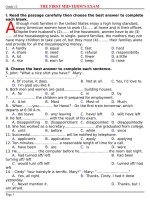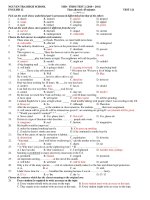Mid term review lecture
Bạn đang xem bản rút gọn của tài liệu. Xem và tải ngay bản đầy đủ của tài liệu tại đây (3.41 MB, 97 trang )
Review
Mid-Term Exam
NOTE: THIS INFORMATION IS DESIGNED TO SUPPLEMENT YOUR MID-TERM EXAM PREPARATION, AND NOT TO BE YOUR
ONLY SOURCE OF REVIEW INFORMATION
To help prepare you for the mid-term exam, be sure to review:
1.
2.
3.
4.
5.
6.
Mid-term exam chapters (1, 2, 3, 4, 5 and 8) – the exam is based on the textbook material and will start at
1:30pm on Tuesday, February 26th in SE06 209.
Textbook chapter summaries.
Your lecture and class notes.
The weekly chapter quizzes.
The material uploaded to the course Learning Hub site.
The textbook website material (i.e., flip cards, audio lectures, quizzes, etc.)
Chapter 1
Management
Copyright © 2018 by Nelson Education Ltd.
Learning Outcomes
After studying this chapter, you will be able to…
1.
Describe what management is.
2.
Explain the four functions of management.
3.
Describe different kinds of managers.
4.
Explain the major roles and subroles that managers perform in their jobs.
Copyright © 2018 by Nelson Education Ltd.
Learning Outcomes
After studying this chapter, you will be able to…
5.
6.
7.
8.
Explain what companies look for in managers.
Discuss the top mistakes that managers make in their jobs.
Describe the transition that employees go through when they are promoted to management.
Explain how and why companies can create competitive advantage through people.
Copyright © 2018 by Nelson Education Ltd.
2
MGMT = E (p. 4 – 5)
Efficiency
Getting work
done through
others
Effectiveness
Copyright © 2018 by Nelson Education Ltd.
The Four Functions of Management (p. 5 – 7)
Copyright © 2018 by Nelson Education Ltd.
Four Functions of Management Defined
• Planning:
•
Determining organizational goals as a means for achieving them.
•
Deciding where decisions will be made, who will do what jobs and tasks, and who will work for whom in
the company.
• Organizing:
• Leading:
•
Inspiring and motivating employees to work hard to achieve organizational goals.
•
Monitoring progress toward goal achievement and taking corrective action when progress isn’t being
made.
• Controlling:
What the Four Kinds of Managers Do (p. 7 – 11)
Jobs
Responsibilities
Top Managers
Change
Commitment
Culture
Environment
Middle Managers
Resources
Objectives
Coordination
Subunit performance
Strategy implementation
First-Line Managers
Nonmanagerial worker supervision
Teaching and training
Scheduling
Facilitation
Team Leaders
Facilitation
External relationships
Internal relationships
Copyright © 2018 by Nelson Education Ltd.
Mintzberg’s Managerial Roles (p. 11 - 16)
Copyright © 2018 by Nelson Education Ltd.
Management Skills (p. 16 – 17)
Copyright © 2018 by Nelson
Education Ltd.
Key Characteristics of Leaders Who Derail
(p. 17 – 18)
1. Difficulty in changing or adapting—resistant to change, learning from mistakes and
developing.
2. Problems with interpersonal relationships—difficulties in developing good working
relations with others.
3. Failure to build and lead a team—difficulties in selecting and building a team.
4. Failure to meet business objectives—difficulties in following upon promises and
completing jobs.
5. Having too narrow a functional orientation—lacking depth to manage outside of
one’s current function.
Copyright © 2018 by Nelson Education Ltd.
Stages in the Transition to Management (p. 19 – 20)
Copyright © 2018 by Nelson Education Ltd.
Competitive Advantage through People
Management Practices in
Top-Performing Companies
1.
2.
3.
4.
5.
6.
7.
Employment Security
Selective Hiring
Self-Managed Teams and Decentralization
High Wages Contingent on Organizational
Performance
Training and Skill Development
Reduction of Status Differences
Sharing Information
Source: J. Pfeffer, The Human Equation: Building Profits by Putting People First (Boston: Harvard Business School Press, 1996.)
Copyright © 2015 by Nelson Education Ltd.
Chapter 8
Designing Adaptive Organizations
Learning Outcomes
After reading this chapter, you should be able to:
1.
Describe the departmentalization approach to organizational structure.
2.
Explain organizational authority.
3.
Discuss the different methods for job design.
4.
Explain the methods that companies are using to redesign internal organizational processes (i.e., intra-organizational
processes).
5.
Describe the methods that companies are using to redesign external organizational processes (i.e., inter-organizational
processes).
Copyright © 2017 by Nelson Education Ltd.
Sony Corporation’s Organizational Chart
Copyright © 2015 by Nelson Education Ltd.
Departmentalization Defined
• A method of subdividing work and workers into separate units that take
responsibility for completing particular tasks.
Departmentalization
Functional
Customer
Product
Geographic
Copyright © 2015 by Nelson Education Ltd.
Matrix
•Copyright © 2017 by
Functional Departmentalization (p. 156 – 157)
ADVANTAGES
Work done by highly qualified specialists
DISADVANTAGES
Cross-department coordination can be
difficult
Lowers costs through reduced duplication
May lead to slower decision making
Communication and coordination
Produces managers with narrow
problems are lessened
experience and expertise
•Copyright © 2017 by
Product Departmentalization:
United Technologies
Copyright © 2015 by Nelson Education Ltd.
Product Departmentalization (p. 157)
ADVANTAGES
Managers specialize
but have broader experiences
DISADVANTAGES
Duplication of activities
leading to higher overall
costs
Easier to assess work-unit performance
Difficult to coordinate across different
product departments
Decision making is faster
•Copyright © 2017 by
•Copyright © 2017 by
Nelson Education Ltd.
Customer Departmentalization (p. 158)
ADVANTAGES
DISADVANTAGES
Focuses on customer needs
Duplication of resources
Products and services tailored to
Difficult to coordinate across
customer needs
departments
Efforts to please customers may hurt the
company
•Copyright © 2017 by









